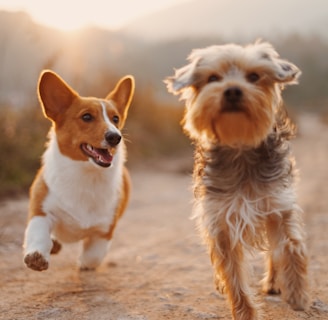How Do I Correct My Puppy's Bad Behavior?
Getting your first puppy? Or your nth? Bringing a new puppy into your home is an exciting experience, but it also comes with its challenges. Early puppy behavior can be adorable, but some actions, if left unchecked, can turn into serious issues as your pup grows. It’s essential to address these behaviors early to ensure your furry friend grows into a well-behaved and well-adjusted. Here are some key puppy behaviors to nip in the bud and tips on how to do it effectively.
Biting and Nipping
Puppies explore the world with their mouths, and while those little nips may seem harmless, they can lead to painful bites as your dog matures. Teaching bite inhibition is crucial.
Tip: Redirect your puppy’s biting to toys and provide gentle but firm corrections when they bite. Consistent training and positive reinforcement will help them understand what’s acceptable.
Jumping on People
Jumping up to greet people is natural for puppies, but it’s important to curb this behavior early. While it might be cute now, it can become problematic as your puppy grows.
Tip: Train your puppy to sit when greeting people. Reward calm behavior and avoid giving attention when they jump. Over time, they’ll learn that sitting gets them the affection they crave.
Chewing on Furniture and Shoes
Puppies are notorious for chewing on anything they can find. While it’s a normal part of teething, it can lead to damaged furniture and belongings if not addressed.
Tip: Provide plenty of chew toys and supervise your puppy closely. When you catch them chewing on something they shouldn’t, redirect them to an appropriate toy.
Resource Guarding
Some puppies may show signs of resource guarding, such as growling or snapping when someone approaches their food or toys. This behavior can escalate if not handled early.
Tip: Teach your puppy to be comfortable with people near their food and toys by practicing “trade” games, where you exchange the item for something better. Positive reinforcement will help them feel safe and secure.
Excessive Barking
Barking is a natural way for dogs to communicate, but excessive barking can be a nuisance. Addressing this behavior early can save you and your neighbors a lot of headaches.
Tip: Identify the cause of the barking—whether it’s boredom, anxiety, or excitement—and address it. Training your puppy to respond to a “quiet” command can also be helpful.
Ignoring Commands
It’s easy to let a cute puppy get away with not following commands, but consistency is key to effective training. Ignoring commands now can lead to a disobedient dog later.
Tip: Start with basic commands like “sit,” “stay,” and “come” using positive reinforcement techniques. Practice these commands daily to build a strong foundation for future training.
Leash Pulling
Walking on a leash is a skill that needs to be taught early. Puppies that pull on the leash can make walks stressful and dangerous.
Tip: Use a no-pull harness and practice leash training in a controlled environment. Reward your puppy when they walk calmly beside you, and stop walking if they start to pull.
As much as we want to keep them as puppies forever, we cant. And correcting these not only benefits you, but them as well as they are on the path to becoming a well-behaved and well-adjusted adult dog. Consistency, patience, and positive reinforcement are your best tools in shaping your puppy’s behavior. By addressing these common issues early, you’ll ensure a happier life for both you and your furbaby.







